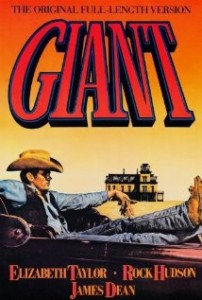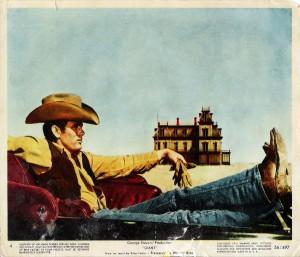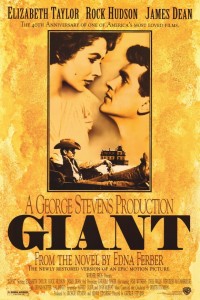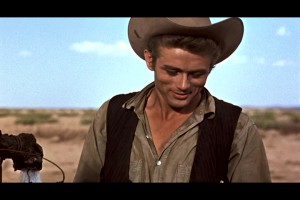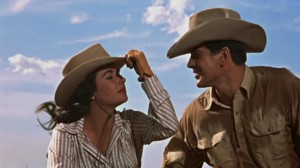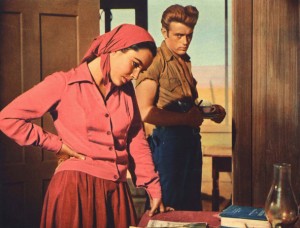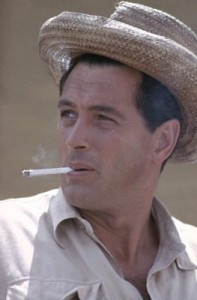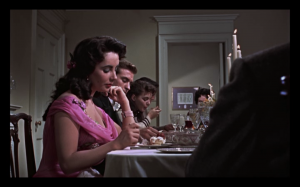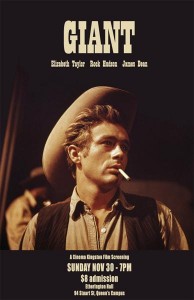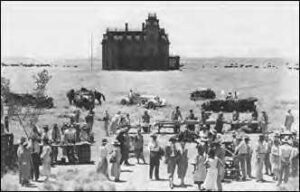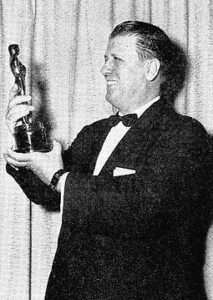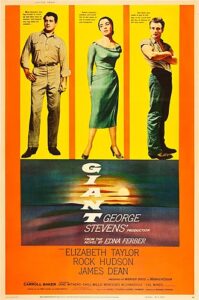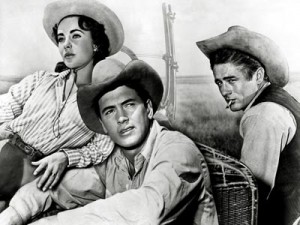Giant **** (1956, James Dean, Elizabeth Taylor, Rock Hudson) – Classic Movie Review 1080
George Stevens’s ambitious 1956 film Giant was a triumph for him, winning the Best Director Oscar. But it is most memorable for 24-year-old James Dean’s final role as bitter entrepreneur Jett Rink, set on destroying the family he was never welcomed into.
Director George Stevens’s ambitious 1956 movie version of Edna Ferber’s Texan family saga was a triumph for him, carrying off the 1957 Oscar for Best Director. But Giant is most memorable now though for showcasing the 24-year-old James Dean’s final film appearance, playing Jett Rink, an embittered entrepreneur set on destroying the family he was never welcomed into.
Ferber’s story starts with Texan rancher Bick Benedict visiting a Maryland farm to buy a prize horse and falling for the farm owner’s daughter, Leslie. They marry in haste there and then and return to his ranch. The story of their family and its rivalry with Jett Rink spans two generations.
Giant presents Dean with a tricky challenge as the first film playing a character role, one which he shows he’s up for, resourcefully ageing from young cowboy to ancient oil tycoon. This role is the third of the trio that combined cements his undying place in popular culture and movie history. Overall, both the film and Dean’s Jett Rink are less popular, less famous and less iconic than his Cal Trask in East of Eden and Jim Stark Rebel Without a Cause, but Giant still has huge cult prestige and entertainment value.
Dean also had the challenge of two major co-stars in Rock Hudson (as Bick Benedict) and Elizabeth Taylor (as Leslie Benedict), who are actually the film’s main stars, have larger roles and certainly weren’t going to let him have things all his way. Taylor is outstanding and, arguably, it is Oscar-nominated Hudson’s greatest performance. It was his one and only nomination. On 8 February 1960 he was given a Star on the Walk of Fame at 6116 Hollywood Blvd.
Giant is a great, sprawling epic story, covering the life of a Texas cattle ranch and its transformation after the discovery of oil. And it is told at great, sprawling epic length (201 minutes). But luckily, there is a banquet of still fresh and exciting performances here to put it over. Dean was posthumously Oscar nominated for the second time in consecutive years after East of Eden. His co-stars Rock Hudson and Elizabeth Taylor are at their peak. The trio form a love triangle that fractures through the demands of family, greed and lust.
And there is eye-catching work from the star character actors too – Mercedes McCambridge, Carroll Baker, Chill Wills, Jane Withers, Dennis Hopper and Sal Mineo (the latter pair both from Dean’s previous film, Rebel Without a Cause).
That ‘sprawling’ word always seems to get applied to Giant and is the giveaway – the movie is a tiny bit languidly paced, pompous and clunky, too aware of its air of self-importance. But, still, Oscar-winning Best Director Stevens manfully keeps control of the narrative and uses his distinguished actors, Arizona locations, William C Mellor’s colour cinematography, Boris Leven’a art direction and Dimitri Tiomkin’s score to the greatest possible effect. There were nine other nominations, but only the one win.
The screenplay is written by Fred Guiol and Ivan Moffat, adapted from Edna Ferber’s 1952 novel.
The day after his part in Giant was completed (on 30 September 1956) Dean ran into another car in his new Porsche and the live-fast-die-young legend began. He became the first actor to receive a posthumous Academy Award nomination.
Although playing their father, Hudson was just six years older than Carroll Baker, nine years older than Fran Bennett and 11 years older than Dennis Hopper. Baker, who plays Taylor’s daughter, was older than Taylor, and Hopper was only four years younger than Taylor.
Hudson, who was paid a modest $100,000 for the movie, said: ‘If you’re cast in crap like Taza, Son of Cochise (1954), it doesn’t matter if you experiment with a scene and it goes wrong. Who’s gonna notice? But if it works, you can use it in a better film. Like Giant, perhaps.’
Budgeted at $2 million, the film ended up costing over $5 million, but it took $39 million and became Warner Bros’ highest grossing film until Superman (1978).
Dean and Hudson didn’t get along, plunging the latter into remorse and guilt when Dean died, but Hudson and Taylor remained lifelong friends.
Dean’s friend Nick Adams was called in to do some voice dubbing for Dean’s role after he was killed in the car crash.
In 2005, the film was selected for preservation in the US National Film Registry by the Library of Congress as ‘culturally, historically or aesthetically significant’. Actually, it is all of those things.
Dean previously appeared in uncredited roles in the 1951 film Fixed Bayonets! as Doggie, in the 1952 film Sailor Beware as Boxing Trainer, in the 1952 film Deadline – USA as Copyboy, in the 1952 film Has Anybody Seen My Gal? as Youth at Soda Fountain, and in 1953 film Trouble Along the Way as Football Spectator.
The Second-empire Victorian mansion facade designed by Boris Leven became an iconic image for the film. Martin Scorsese opined: ‘I like Boris Leven’s image of the house, and the changes in the house.’
The cast are Elizabeth Taylor as Leslie Lynnton Benedict, Rock Hudson as Jordan ‘Bick’ Benedict Jr, James Dean as Jett Rink, Jane Withers as Vashti Hake Snyth, Robert Nichols as Mort ‘Pinky’ Snyth, Chill Wills as Uncle Bawley, Mercedes McCambridge as Luz Benedict, Carroll Baker as Luz Benedict II, Dennis Hopper as Jordy Benedict III, Fran Bennett as Judy Benedict, Earl Holliman as Bob Dace, Elsa Cárdenas as Juana Villalobos Benedict, Paul Fix as Dr Horace Lynnton, Judith Evelyn as Mrs Nancy Lynnton, Carolyn Craig as Lacy Lynnton, Rod Taylor as Sir David Karfrey, and Sal Mineo as Ángel Obregón II.
The Oscar nominations are for Best Motion Picture (George Stevens and Henry Ginsberg), Best Director (George Stevens), Best Actor (James Dean), Best Actor (Rock Hudson), Best Supporting Actress (Mercedes McCambridge), Best Screenplay – Adapted (Ivan Moffat and Fred Guiol), Best Art Direction – Color (Boris Leven and Ralph S Hurst, Best Costume Design – Color (Moss Mabry and Marjorie Best), Best Film Editing (William Hornbeck, Philip W Anderson and Fred Bohanan) and Best Music Score of a Dramatic or Comedy Picture (Dimitri Tiomkin).
Especially considering the film’s total lack of Oscar success otherwise, George Stevens must have been very pleased with himself to carry off the Best Director statue. He had five nominations as Best Director, winning twice, previously for A Place in the Sun (1951). He had been a comedy director. He worked as director of photography and a gag writer on 35 Laurel and Hardy short films, such as Bacon Grabbers (1929) and Night Owls (1930). But immediately after finishing The More the Merrier (1943), he went to North Africa with the US Army’s combat photography unit. The More the Merrier was Stevens’s last comedy, turning to drama and Westerns after the war.
Carroll Baker won a Golden Globe Award as Most Promising Newcomer – Female (also for Baby Doll).
The making of Giant is the background to the play and film Come Back to the 5 & Dime, Jimmy Dean, Jimmy Dean.
Giant is a fairly obvious inspiration for the 1980s TV show Dallas.
Martin Scorsese said: ‘I’ve seen this film more than 40 times. I don’t like the obvious romanticism, and it’s very studied. But there’s more here than people have seen. It has to do with the depiction of a lifestyle through the passage of so many years. You see people grow. I like James Dean. I like the use of music. Giant is an inspiring film, visually. It’s all visual.’
http://derekwinnert.com/east-of-eden-1955-james-dean-classic-film-review-1079/
http://derekwinnert.com/rebel-without-a-cause-classic-film-review-658/
© Derek Winnert 2014 Classic Movie Review 1080
Check out more reviews on http://derekwinnert.com/

